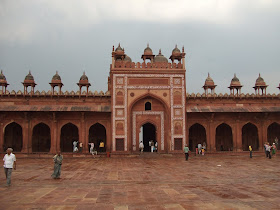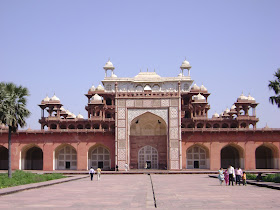Delhi:
The Qutb Minar towers over the historic site where Qutubuddin Aibak laid the foundations of the Delhi Sultanate (the first Muslim kingdom in North India) in 1193. The architecture is a patchwork of decorative panels of Hindu origin - with bells and garlands, and Islamic domes and arches.




Emperor Humayun's Tomb, built in loving memory by his Senior Queen Haji Begum in 1565. This perfectly symmetrical structure of red sandstone and white marble was built by Persians. The plain white marble sarcophagus stands on a simple black and white marble platform. Humayun's family is also buried in the complex.




India Gate and Parliament Square.


Ajmer:
The Shrine of Khwaja Mainuddin Chishti, is the most famous Muslim shrine in the subcontinent. Thw two mosques in the shrine area were built by Emperors Akbar and Shah Jahan. The shrine is reached through a labyrinth of narrow streets, dotted with mosques and shops and houses. Pilgrims to the Dargah include not only Muslims but also Hindus and people of other faiths. A special rice pudding is cooked in huge cauldrons for the devotees.

Remains of the 12th century Taragarh Fort are found on the summit of the Beetli Hill. The Shrine of Meeran Shah is also situated there.


The marble pavillions of Daulat Bagh were built on the banks of the Ana Sagar by Emperor Shah Jahan in the 17th century.


Jaipur:
Amber Fort was built atop a hill by King Man Singh in 1592. Protected by the nearby Jaigarh Fort, the massive ramparts of Amber Fort follow the contours of a natural ridge. It houses a beautiful Sheesh Mahal (Hall of Mirrors), the Jai Mandir with its floral ceiling of alabaster and glass, and the elegant three-storied gateway of Ganesh Pol. The temple of the family deity Shila Devi has silver doors. The zenana mahal has latticework marble screens and a 12-pillared pavilion called the Baradari. Today, one can ride a colorfully decked out elephant to the entrance of the Fort (oooohhh, so exciting!!!), or opt for the boring motorized vehicle.




Jantar Mantar, an observatory built by Sawai Jai Singh II, has 16 instruments like the Rashivalaya Yantra (used by astrologers to draw up horoscopes) and the Ram Yantra, whose readings determine the celestial arc from horizon to zenith, as well as the altitude of the sun. Some of the instruments in the complex are still used.


The Hawa Mahal (Palace of Winds) has an unusual facade, built to resemble the crown of the Hindu God Krishna. It is a five-storied building constructed of red and pink sandstone, with 953 windows on the street side, which allow the breeze to circulate. Its original intention was to allow royal ladies to observe everyday life in the street below without being seen. There are no stairs to reach the upper floors, only ramps, and the roofs are quite low.


The Jal Mahal (Water Palace) was built in the middle of Man Sagar mainly for Royal duck shooting parties. Built in 1799, the palace is now abandoned, but reasonably well preserved. The first four floors of this building is under water, only the top floor remains outside.

The Albert Hall (now a museum) is a fine example of Indo-Saracenic architecture. It houses an exquisite collection of metalware, decorative marble and procelain pieces, miniature portraits, sculptures, paintings, costumes, pottery and woodwork.
Fatehpur Sikri:
Built to honor the Sufi Saint Salim Chishti, this was the Mughal capital for 14 years. This walled city has imposing gateways and an architecture which is a blend of hindu, islamic and christian styles, and clearly reflects Emperor Akbar's secular outlook. Akbar's first wife Jodha Bai's palace is the largest residence in the complex, but his Muslim wife, the Turkish Sultana's house has the most delicately sculpted walls and fine dado panels. There is the Annop Talao, the pool with a seating area in the middle where Akbar's renowned court musician Mian Tansen used to sing. The Panch Mahal, a five-storied open sandstone pavilion was built for Akbar's wives to enjoy the evening breeze.




The Shrine of Muslim sufi saint Salim Chishti is situated within the courtyard of the Jame Masjid. The shrine is built of exquisite white marble, and almost transparent screens surround the tomb, which has a sandalwood canopy inlaid with mother-of-pearl. The mosque complex can be entered through the Badshahi Darwaza and the Bulund Darwaza.


And the icing on the cake for the Blogging Girl, as for every visitor to India, was the Taj Mahal, one of the seven wonders of the world. It was built by Emperor Shah Jahan in memory of his wife Mumtaz Mahal, and took 12 years to be completed in 1643. The exquisite white marble creation appears almost ethereal from a distance, and up close, the details of the decorative elements are mesmerizing.






The Blogging Girl had only one regret: the trip was too short for her to really savour the sights in all their glorious details. And there were many, so many many, that she did not have the time to see. So she is already planning her next (and, ahem, extended) trip to these cities...
Built to honor the Sufi Saint Salim Chishti, this was the Mughal capital for 14 years. This walled city has imposing gateways and an architecture which is a blend of hindu, islamic and christian styles, and clearly reflects Emperor Akbar's secular outlook. Akbar's first wife Jodha Bai's palace is the largest residence in the complex, but his Muslim wife, the Turkish Sultana's house has the most delicately sculpted walls and fine dado panels. There is the Annop Talao, the pool with a seating area in the middle where Akbar's renowned court musician Mian Tansen used to sing. The Panch Mahal, a five-storied open sandstone pavilion was built for Akbar's wives to enjoy the evening breeze.




The Shrine of Muslim sufi saint Salim Chishti is situated within the courtyard of the Jame Masjid. The shrine is built of exquisite white marble, and almost transparent screens surround the tomb, which has a sandalwood canopy inlaid with mother-of-pearl. The mosque complex can be entered through the Badshahi Darwaza and the Bulund Darwaza.


Agra:
Agra Fort, on the west bank of the river Jamuna, was built by Emperor Akbar between 1565 and 1573. The buildings range from the eclecticism of Akbar to the sublime elegance of Shah Jahan. The Diwan-i-Am, with its colonnaded arches, once housed the fabled Peacock Throne. The octagonal Musamman Burj has a clear view of the Taj Mahal. This is where Shah Jahan had been imprisoned by his son Aurangzeb, and spent the last years of his life. His two daughters, Jahanara and Roshanara, also lived in the Khas Mahal, in the two golden pavillions with Bangaldaar roofs. The Forth also houses the Mina Masjid, probably the world's smallest mosque, built for the Emperor's private use.











Lord Treasurer of the Mughal Empire Itimad-ud-Dawla's Tomb is on the east bank of the Jamuana. It was built by his daughter Queen Nur Jahan. This garden tomb is an exquisite combination of white marble, colored mosaic, stone inlay and lattice work. The yellow marble caskets appear at first glance to be carved out of wood!




Emperor Akbar is buried in the small village of Sikandra. Entry to this symmetrical complex is through a massive red sandstone gate with an exuberant polychrome mosaic of inlaid white marble, black slate and colored stone. On each corner are marble minarets. Floral and arabesque designs are carved into the entry hall of the tomb chamber, as well as Chinese patterns and the 99 names of Allah. A vast number of deer and monkeys are seen within the walled garden.




Agra Fort, on the west bank of the river Jamuna, was built by Emperor Akbar between 1565 and 1573. The buildings range from the eclecticism of Akbar to the sublime elegance of Shah Jahan. The Diwan-i-Am, with its colonnaded arches, once housed the fabled Peacock Throne. The octagonal Musamman Burj has a clear view of the Taj Mahal. This is where Shah Jahan had been imprisoned by his son Aurangzeb, and spent the last years of his life. His two daughters, Jahanara and Roshanara, also lived in the Khas Mahal, in the two golden pavillions with Bangaldaar roofs. The Forth also houses the Mina Masjid, probably the world's smallest mosque, built for the Emperor's private use.











Lord Treasurer of the Mughal Empire Itimad-ud-Dawla's Tomb is on the east bank of the Jamuana. It was built by his daughter Queen Nur Jahan. This garden tomb is an exquisite combination of white marble, colored mosaic, stone inlay and lattice work. The yellow marble caskets appear at first glance to be carved out of wood!




Emperor Akbar is buried in the small village of Sikandra. Entry to this symmetrical complex is through a massive red sandstone gate with an exuberant polychrome mosaic of inlaid white marble, black slate and colored stone. On each corner are marble minarets. Floral and arabesque designs are carved into the entry hall of the tomb chamber, as well as Chinese patterns and the 99 names of Allah. A vast number of deer and monkeys are seen within the walled garden.




And the icing on the cake for the Blogging Girl, as for every visitor to India, was the Taj Mahal, one of the seven wonders of the world. It was built by Emperor Shah Jahan in memory of his wife Mumtaz Mahal, and took 12 years to be completed in 1643. The exquisite white marble creation appears almost ethereal from a distance, and up close, the details of the decorative elements are mesmerizing.






The Blogging Girl had only one regret: the trip was too short for her to really savour the sights in all their glorious details. And there were many, so many many, that she did not have the time to see. So she is already planning her next (and, ahem, extended) trip to these cities...








Nice documentation.....some lovely capture....liked it very much
ReplyDeleteWow ! :) You depicted india beautifully!! :) I am going to be emailing you with some qns about Dhaka soon!
ReplyDeleteAnd I hope the next time you are in India I can show you my city - mumbai! :)
Excellent photos! They are both instructive and entertaining. Please keep up the good work.
ReplyDeleteAwesome places and pictures!!!
ReplyDeleteI'm argentine sport journalist and I'm looking for a Bangladesh football blog. If you know one, please, write me to contact the blogger.
Best regards from Buenos Aires
Pablo
My site: International football journalism